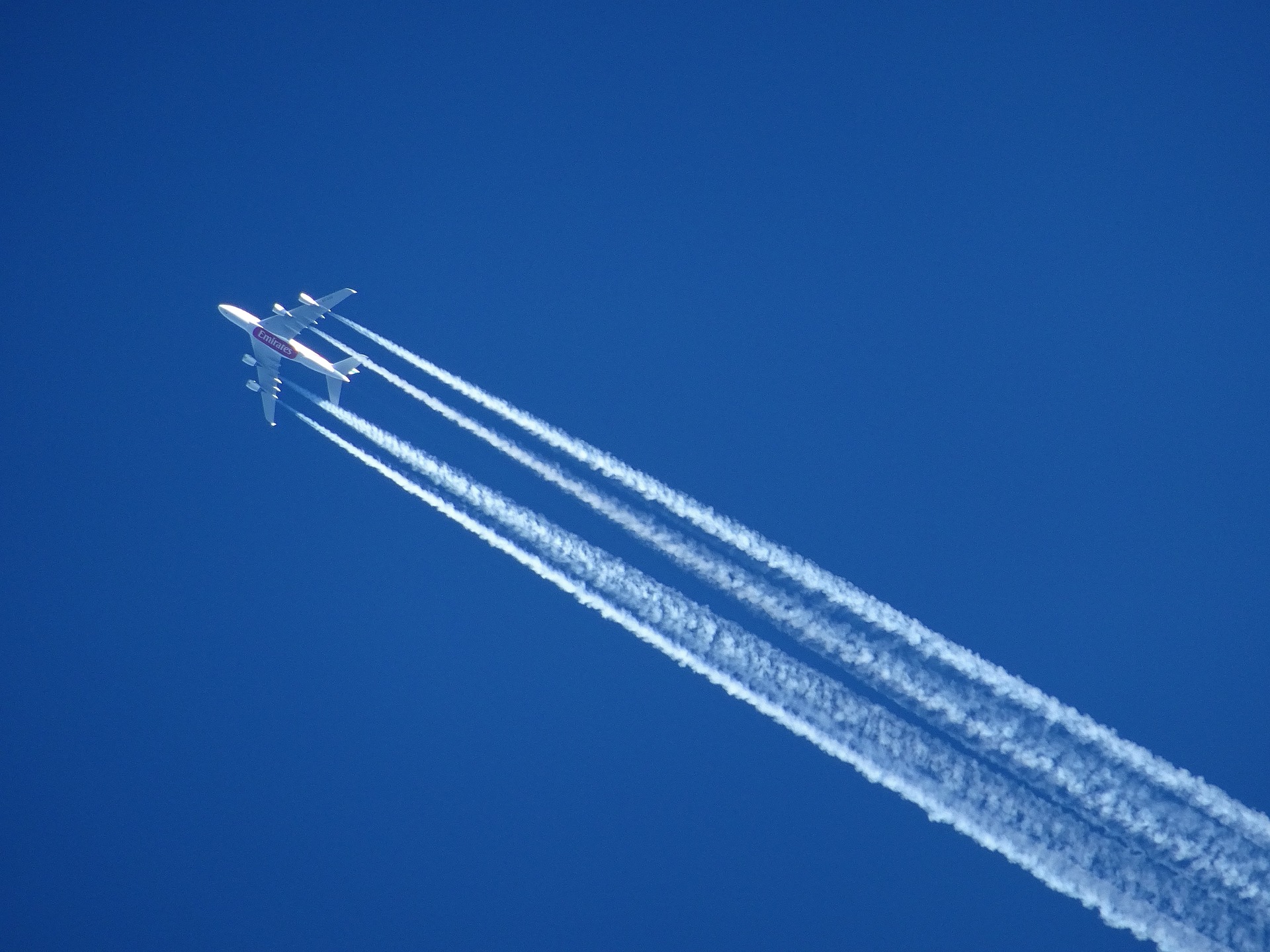The summer of ’23 gives us record temperatures, and scientists relate this to man made climate changes caused by the burning of fossil fuels. Travelers now increasingly look for ways to cut their travel related carbon footprints.
Real emission cuts, not carbon offsets
Various travel planning websites identify flights having lower emissions than average for trips from A to B. Use this important information to control your carbon footprint, and also to support airlines offering flights with lower emission levels.
PanFlights takes it further by creating routes using a combination of transport modes. By mixing flights with surface transport substantial emission reductions can often be made. Since we usually include a flight component in mixed transport routes, that should allow you to reach your destination within reasonable time. If the overland travel duration is considered short enough, we suggest a route without flights as the most sustainable one.
PanFlights started as a flights only search engine in 2016, and has gradually added its own route suggestions where use of overland transport can improve your trip. Routes that include trains or buses can be more sustainable, cheaper and you get to see more cities and landscapes instead of airport lounges.
The duration of such routes can be comparable to a connected flight with a long layover. Routes from A to B can also span multiple days, which can be preferential when you have the time for that.
How mixing transport modes can cut emissions
With our method we identify flights within moderate overland reach that take you a substantial part of the way towards your destination. With this combination of travel modes you can often replace an indirect flight with a non-stop flight. It opens for possibilities such as
- Fewer takeoffs are needed. Typically one instead of two
- You fly more directly towards your destination, reducing the total distance flown
- You reach flights causing less emissions per distance unit flown
- If you travel overland in the direction of your destination the flight distance is reduced accordingly
An example route with reduced emissions
An example trip from Aberdeen to Leipzig offers great potential for reducing emissions compared to flying all the way.
Due to the obstacle of the North Sea, traveling the full distance overland requires a considerable detour. There are no direct flights between Aberdeen and Leipzig. Most flights actually require two connections. The fastest flight that came up in my search costed £1,701 and releases an estimated 198 kg (437 lbs) CO2. The most eco-friendly flights-only result was via London, including a change of airports from Heathrow to Stansted, and came out at 123 kg (271 lbs) CO2.
PanFlights suggested among its more sustainable options that you first travel overland from Union Square in Aberdeen and straight to Edinburgh Airport. From there you have a direct flight across the North Sea to Berlin. Once there you will find many direct trains and buses to Leipzig. Among those direct buses directly from the airport. Schedules are shown, with links to booking options.
The estimated emission is 83 kg (192 lbs) CO2 and the price £148. This includes price estimates for overland segments.
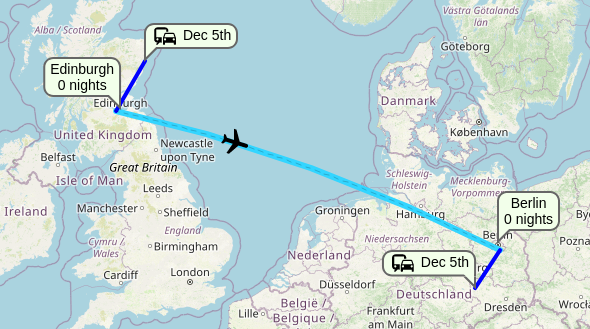
We are continuously adding more schedules. Below is a screenshot of options found for December 12th, 2023. You may want to do an updated search on our platform.
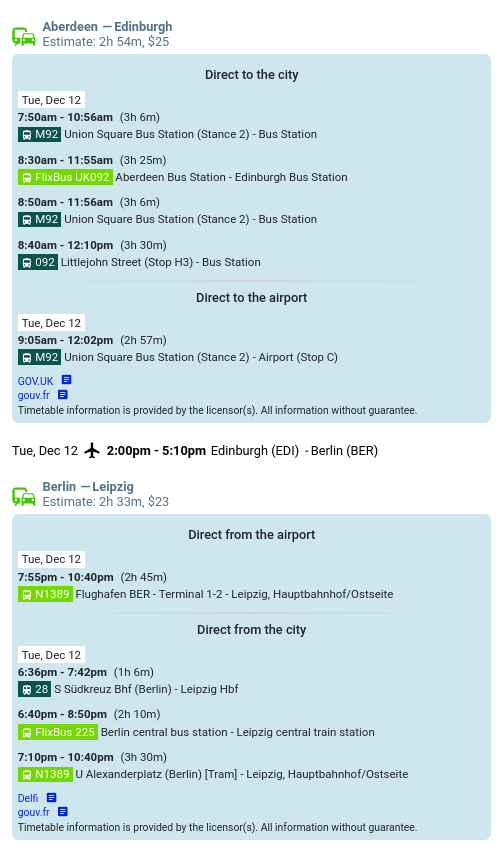
Visiting a climate conference
In Norway we had a lot of coverage regarding more sustainable travel from Oslo to the climate conference COP26, held in Glasgow in 2021. Again, the North Sea blocks a direct overland route, and there are no direct flights between Oslo and Glasgow.
Flight search engines typically suggest indirect flights via hubs such as Amsterdam or London for this search. The minimum emission estimate for such routes is around 140 kg (309 lbs) CO2.
PanFlights will likely suggest as the most sustainable option that you take the train from Oslo to Stavanger. From there you have a low-carbon, direct flight across the North Sea to Aberdeen. Once in Scotland you will find many direct trains and buses to Glasgow. The combined emission estimate for this bundle was 47 kg (104 lbs) CO2 at the time of writing.
To see if it is available now, do the search and make sure results are ordered by CO2.
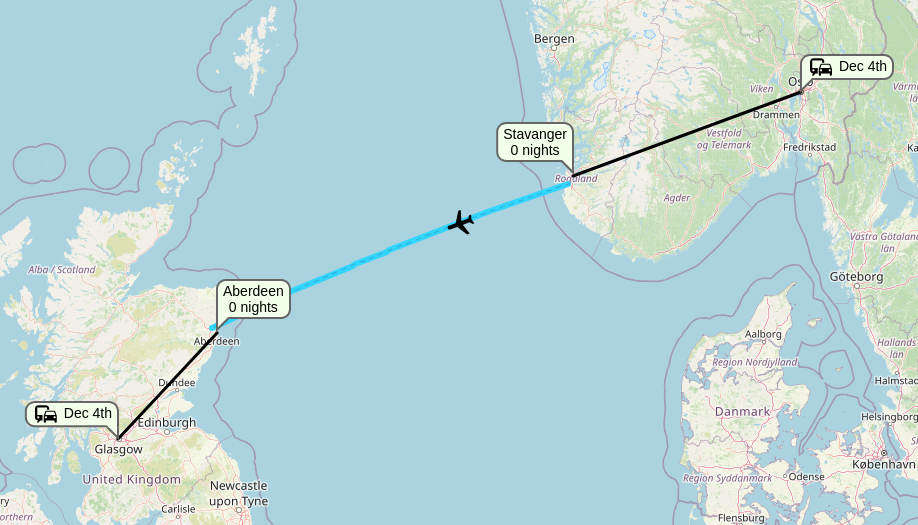
Moving forward to 2023, the yearly UN climate conference is held in Dubai and labeled COP28. It is often assumed that flying direct results in the lowest emissions. But this is not always the case.
For instance, a direct flight from Oslo to Dubai is estimated to cause 360 kg CO2. PanFlights showed as a reduced emission alternative a two flights + one train combination via Gdansk and Warsaw with an estimated emission of 292 kg CO2.
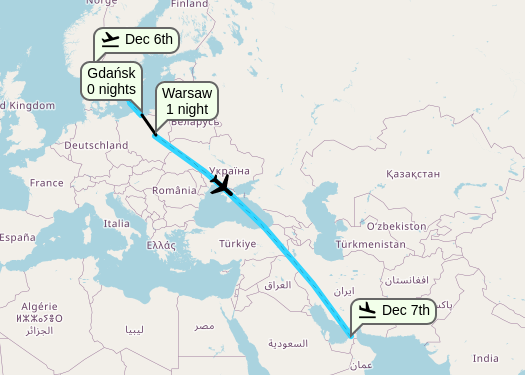
Below you will see a few options for getting between Gdansk and Warsaw.
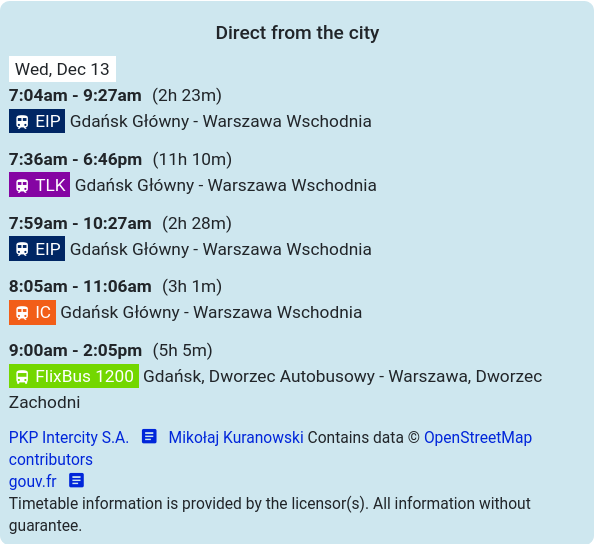
Interestingly, the savings of 68 kg CO2 by not flying direct, but instead flying indirect and adding a moderate train ride of 3.5 hours was more than the 47 kg CO2 estimated for the trip from Oslo to Glasgow for the COP26-conference.
Flights and overland legs are booked separately
Currently, direct booking links for flight legs only are available in our system. For other modes of transport we offer links to 3rd party websites where you can search for and book tickets. This allows for great personal customization, but it also requires more planning than if you had bought the trip as a ready-made package.
We currently suggest overland legs based on scheduled routes, as well as the availability of roads, railway lines and ferries. We label those legs “Own way”. Estimates for price and duration are given. For instance, for the leg from Oslo to Stavanger below we estimate a travel duration of 8h 27m, and a price of €88.
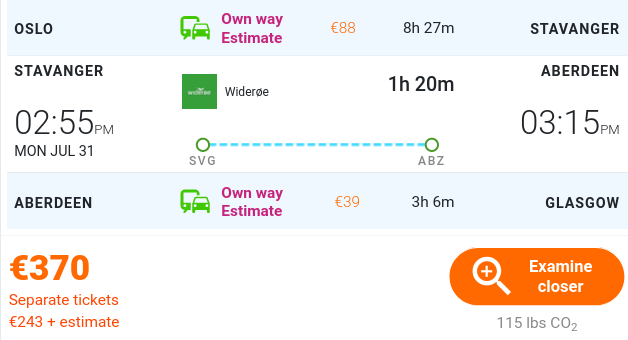
Note that you will not always find direct public transport along the overland routes we show. In such cases traveling indirectly or driving a car may be viable.
Between nearby cities there will usually be frequent public transport available. With increasing distance and decreasing city sizes, the likelihood of finding a direct route goes down. The availability of public transport also depends on other factors.
When legs are booked separately it implies there will be no connection guarantees given between legs. I therefore recommend that you allow sufficient extra time between connections, or to get a travel insurance that covers missed connections. Alternatively, you just handle it as it comes in case of delays. If there are frequent cheap public transport options, missing one is less critical.
Industry standard flight emission estimates
PanFlights shows emission estimates for each leg in the trip details view. For information about how estimates are calculated, hover the small information icon to the right of the estimated value, as shown in the screenshot below.
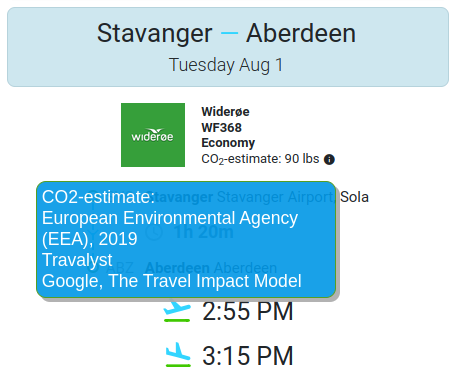
We facilitate flight emissions estimated by the Travel Impact Model, which Google administrates in cooperation with the Travalyst Coalition and the International Council on Clean Transportation. These estimates are now an industry standard for calculating aviation emissions as several large travel companies use them.
Adjusting for non-CO2 warming effects
Emissions at high altitude have the potential to cause additional warming due to factors such as the forming of contrails and NOx-emissions. Contrails trap heat from the air below that would otherwise be released into space.
The scientific community often operates with a multiplier for CO2 emissions when trying to take the additional impact into account.
Our emission estimates do as default not include a multiplier such as the Radiative Forcing Index (RFI) or the 100-year Global Warming Potential (GWP*100) to compensate. Estimating this is complicated, and using a multiplier based on CO2-emissions will never give a good estimate on a flight by flight basis.
To exemplify the dilemma, contrails form predominantly under certain atmospheric conditions. If flying outside such conditions, less contrails will form. But we get more CO2-emissions if the aircraft makes a detour to avoid the problematic atmospheric region.
In PanFlights you can select a multiplier in the settings. With a value larger than 1 our routes involving overland transport typically become more prominent among low-carbon alternatives.
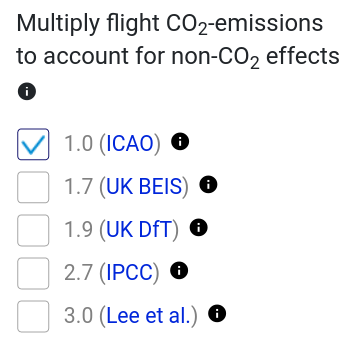
Avoid being locked to a particular provider
Our goal is to offer you the widest possible variety of travel options. This would not be possible without linking to 3rd parties for refinements and bookings. The better information and range of options you have access to, the more emission cuts you can do.
Companies, public institutions and other organizations sometimes make agreements with a specific travel provider and commit to purchase all trips via that provider. This decreases their choice of travel options, and thus limits their ability to travel more sustainably.
Airline loyalty programs can have a similar effect in that users are given incentives for picking a particular provider instead of taking the most sustainable route.
Speak out about your emission savings
Journalists, bloggers and people with many followers on social media have a tremendous audience size. With this comes the potential to shape travel culture in a more sustainable direction. When you reference our work that helps our eco-focused company gain visibility and grow.
When others see how to cut emissions and still travel swiftly and conveniently with our route suggestions they will be encouraged to try the same. I therefore invite you to share your newfound travel routes in news articles, blog posts, with your friends and on social media.
This is vital in order to allow people access to our green solutions.
People normally go online to discover new information. Ranking in search engines depends largely on brand strength and search engine optimization budget. With the need to spend big on marketing, less resources will be available for developing green innovations.
We have included a fun way you can share your itinerary with an animation on the details page. Here is an example from the mentioned trip from Aberdeen to Leipzig.
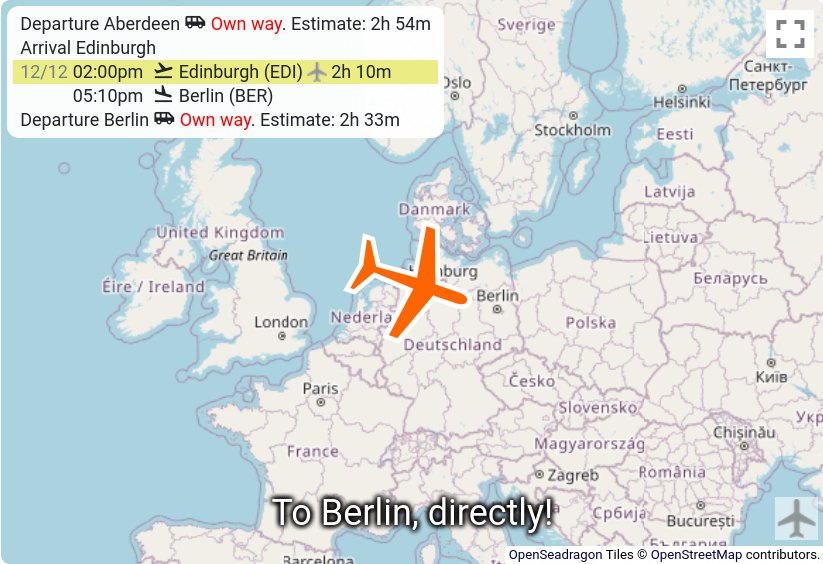
All map tiles are © Openstreetmap contributors.

